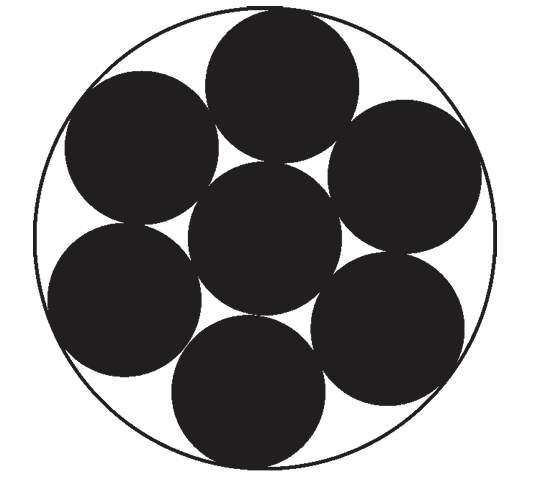
GRE Prep Club Daily Prep
Thank you for using the timer - this advanced tool can estimate your performance and suggest more practice questions. We have subscribed you to Daily Prep Questions via email.
Customized
for You
Track
Your Progress
Practice
Pays
Not interested in getting valuable practice questions and articles delivered to your email? No problem, unsubscribe here.
In the figure below, what percent of the larger circle is unshaded,
[#permalink]
 07 Aug 2025, 00:35
07 Aug 2025, 00:35
Expert Reply
1
Bookmarks
Question Stats:
 100% (02:00) correct
100% (02:00) correct
 0% (00:00) wrong
0% (00:00) wrong  based on 9 sessions
based on 9 sessions
Hide Show timer Statistics
In the figure below, what percent of the larger circle is unshaded, if all the circles inside the larger circle have the same area and they touch each other as shown?

GRE In the figure below, what percent of the larger circle .png [ 42.03 KiB | Viewed 543 times ]
A. 20%
B. 22.22%
C. 24.33%
D. 27%
E. 44.44%
Attachment:
GRE In the figure below, what percent of the larger circle .png [ 42.03 KiB | Viewed 543 times ]
A. 20%
B. 22.22%
C. 24.33%
D. 27%
E. 44.44%
Re: In the figure below, what percent of the larger circle is unshaded,
[#permalink]
 15 Aug 2025, 10:39
15 Aug 2025, 10:39
Expert Reply
Step 1: Understand the arrangement
The six smaller circles form a ring with one smaller circle in the center. This is a common packing pattern.
Step 2: Define variables
Let the radius of each smaller circle be $r$.
Their area is:
$$
\(A_{\text {small }}=\pi r^2\)
$$
Step 3: Larger circle radius and arrangement
- The center small circle has radius $r$.
- The six outer small circles are arranged around this center circle, and each touches it and its two neighboring small circles.
The centers of the outer six small circles form a regular hexagon around the center circle's center.
The distance from the center circle's center to each outer circle's center is $2 r$ because each small circle touches the center circle.
Hence, the radius of the larger circle must cover the outer circle radius plus $r$ (the radius of the outer small circle).
So the radius $R$ of the larger circle is:
$$
\(R=3 r\)
$$
Step 4: Areas of the circles
- Area of one smaller circle:
$$
\(\pi r^2\)
$$
- Total area of the 7 smaller circles:
$$
\(7 \pi r^2\)
$$
- Area of the larger circle:
$$
\(\pi R^2=\pi(3 r)^2=9 \pi r^2\)
$$
Step 5: Calculate unshaded area and percent
- Unshaded area in the larger circle:
$$
\(9 \pi r^2-7 \pi r^2=2 \pi r^2\)
$$
- Percent unshaded relative to larger circle:
$$
\(\frac{2 \pi r^2}{9 \pi r^2} \times 100=\frac{2}{9} \times 100=22.22\) %
$$
Answer:
$22.22 %$ of the larger circle is unshaded.
The six smaller circles form a ring with one smaller circle in the center. This is a common packing pattern.
Step 2: Define variables
Let the radius of each smaller circle be $r$.
Their area is:
$$
\(A_{\text {small }}=\pi r^2\)
$$
Step 3: Larger circle radius and arrangement
- The center small circle has radius $r$.
- The six outer small circles are arranged around this center circle, and each touches it and its two neighboring small circles.
The centers of the outer six small circles form a regular hexagon around the center circle's center.
The distance from the center circle's center to each outer circle's center is $2 r$ because each small circle touches the center circle.
Hence, the radius of the larger circle must cover the outer circle radius plus $r$ (the radius of the outer small circle).
So the radius $R$ of the larger circle is:
$$
\(R=3 r\)
$$
Step 4: Areas of the circles
- Area of one smaller circle:
$$
\(\pi r^2\)
$$
- Total area of the 7 smaller circles:
$$
\(7 \pi r^2\)
$$
- Area of the larger circle:
$$
\(\pi R^2=\pi(3 r)^2=9 \pi r^2\)
$$
Step 5: Calculate unshaded area and percent
- Unshaded area in the larger circle:
$$
\(9 \pi r^2-7 \pi r^2=2 \pi r^2\)
$$
- Percent unshaded relative to larger circle:
$$
\(\frac{2 \pi r^2}{9 \pi r^2} \times 100=\frac{2}{9} \times 100=22.22\) %
$$
Answer:
$22.22 %$ of the larger circle is unshaded.

gmatclubot
Re: In the figure below, what percent of the larger circle is unshaded, [#permalink]
15 Aug 2025, 10:39
Moderators:



